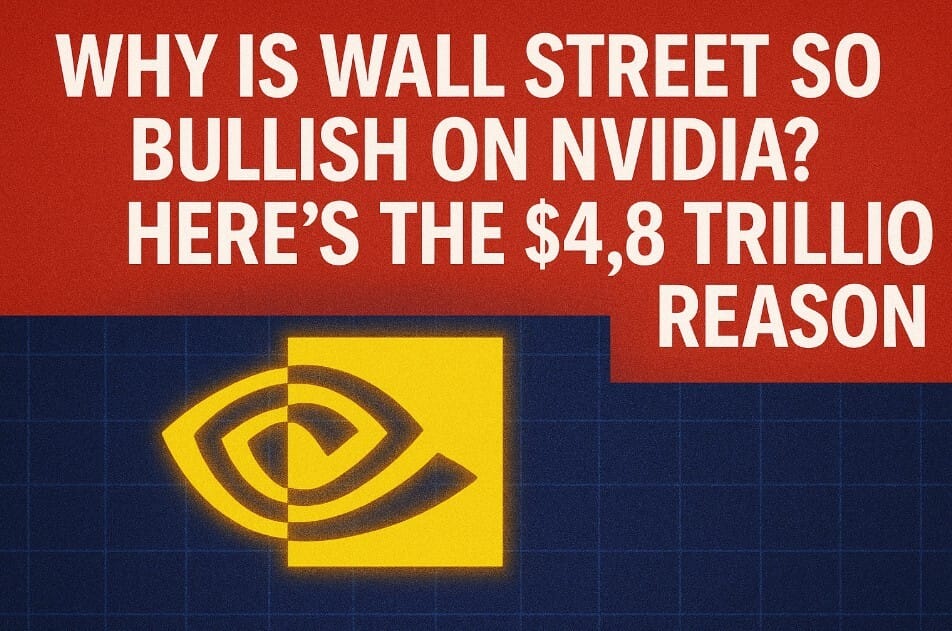- Live Life Grow Wealth
- Posts
- Why Is Wall Street So Bullish on Nvidia? Here's the $4.8 Trillion Reason
Why Is Wall Street So Bullish on Nvidia? Here's the $4.8 Trillion Reason

Today’s Headline
Why Is Wall Street So Bullish on Nvidia? Here's the $4.8 Trillion Reason
If you've been paying even the slightest attention to the stock market this year, you've probably seen Nvidia (NVDA) all over the headlines. It’s not just another tech stock anymore. It’s become the poster child of the AI boom, the golden ticket investors are piling into.
But here’s the question I keep getting from readers like you:
Why is Wall Street so obsessed with Nvidia?
Why are analysts raising their price targets again and again, even after Nvidia’s market value crossed $3 trillion?
The answer lies in a massive opportunity that’s just getting started—a $4.8 trillion reason, to be exact. In this newsletter, I’ll break it all down in simple terms, explain why Nvidia is riding this powerful wave, and share my personal take on what to do next if you’re thinking of investing.
Learn from this investor’s $100m mistake
In 2010, a Grammy-winning artist passed on investing $200K in an emerging real estate disruptor. That stake could be worth $100+ million today.
One year later, another real estate disruptor, Zillow, went public. This time, everyday investors had regrets, missing pre-IPO gains.
Now, a new real estate innovator, Pacaso – founded by a former Zillow exec – is disrupting a $1.3T market. And unlike the others, you can invest in Pacaso as a private company.
Pacaso’s co-ownership model has generated $1B+ in luxury home sales and service fees, earned $110M+ in gross profits to date, and received backing from the same VCs behind Uber, Venmo, and eBay. They even reserved the Nasdaq ticker PCSO.
Paid advertisement for Pacaso’s Regulation A offering. Read the offering circular at invest.pacaso.com. Reserving a ticker symbol is not a guarantee that the company will go public. Listing on the NASDAQ is subject to approvals.
The AI Megatrend Is Not a Buzzword—It’s a Movement
Let’s start with the obvious: Nvidia is riding the AI tsunami.
You’ve heard about ChatGPT. You’ve probably used some kind of AI tool recently. But what you might not realize is this:
Every time you ask a chatbot a question, generate an image, or even run voice-to-text, it’s likely powered by Nvidia’s chips.
And not just regular chips. These are high-performance GPUs (graphics processing units) that crunch massive amounts of data. Nvidia builds the brains that power the AI revolution.
The $4.8 Trillion Reason: Enterprise AI Spending
So where’s this giant $4.8 trillion number coming from?
According to multiple market estimates, global enterprise AI spending—which includes companies using AI to improve operations, automate processes, and enhance products—is expected to grow to nearly $4.8 trillion in total market size over the next 10 years.
That’s almost five trillion dollars being poured into AI-related infrastructure, software, and services. And guess what?
Nvidia is right in the middle of all of it.
Wall Street Sees the Profit Engine Behind the Hype
Now, just because a trend is hot doesn’t mean every company wins. What makes Nvidia special is they aren’t just participating—they’re dominating.
Here’s what Wall Street loves about Nvidia right now:
Market Leader in AI Chips
Nvidia holds more than 80% of the AI GPU market. When companies like OpenAI, Google, Amazon, or Microsoft build AI systems, they use Nvidia’s hardware.Recurring Demand from Big Tech
Cloud giants are buying thousands of Nvidia chips every quarter. These aren’t one-time purchases—this is ongoing infrastructure spending.High Margins and Explosive Growth
Nvidia is one of the few tech companies that’s growing over 100% year-over-year—and still expanding its profit margins.Software and Ecosystem
It’s not just hardware. Nvidia has built a powerful software stack (like CUDA and AI frameworks) that locks customers into their platform.
How Big Is the Opportunity, Really?
Let me paint a picture.
Right now, most of the world’s AI is still in its early stages. It’s like the internet in the late 1990s—everyone’s talking about it, but we haven’t even scratched the surface of what it can do.
Over the next 5–10 years, here’s what’s expected to grow fast:
AI in healthcare: Diagnosing diseases faster
AI in finance: Fraud detection and smart trading
AI in logistics: Real-time route optimization
AI in retail: Personalized shopping experiences
AI in education: Custom learning tools
Each of these industries will spend billions to adopt AI. Nvidia is the arms dealer in this AI race. That’s why investors see a clear path to trillions in market impact, with Nvidia as a core beneficiary.
Why Analysts Keep Upgrading Nvidia
In 2023, analysts were already bullish on Nvidia. But in 2024 and now in 2025, they’ve doubled down.
Why?
Because Nvidia has kept beating expectations—not once, not twice, but quarter after quarter. Each time Wall Street thought growth might slow down, Nvidia pulled out a surprise.
Some analysts now believe Nvidia’s revenue could reach $200 billion annually in the next few years, up from just $27 billion in 2022. That’s a nearly 10x jump in a short span. Very few companies in history have pulled that off.
What About the Competition?
Now, let’s stay honest—competition is coming.
AMD is building powerful AI chips (MI300X).
Intel is investing in next-gen silicon.
Even Google, Amazon, and Microsoft are developing their own in-house chips.
But here’s what gives Nvidia a lead:
Time advantage: Nvidia started working on AI chips nearly 10 years ago.
Software moat: Their ecosystem is hard to leave.
Customer loyalty: Major AI companies have built systems around Nvidia’s architecture.
So while others may catch up eventually, Nvidia has a big head start—and they’re using it wisely.
What I Personally Like About Nvidia’s Business Model
As an investor myself, I love a few things about how Nvidia runs:
Aggressive Innovation
They release new chips every year (like H100, B100), and each one is a major leap forward.Smart Capital Allocation
Nvidia isn’t wasting money. They reinvest wisely, and their cash flow is massive.Visionary Leadership
CEO Jensen Huang is respected even by his competitors. His vision for AI and accelerated computing is bold and clear.
But Let’s Stay Balanced—Here Are the Risks
Nothing in the stock market is ever a sure thing. And Nvidia, for all its strengths, isn’t immune to risk.
High Valuation
Nvidia trades at a premium. That means even a small miss in earnings could cause a big drop in the stock.Customer Concentration
A large part of Nvidia’s revenue comes from a few big cloud companies. If any of them reduce spending, it could hurt.Global Tensions
Nvidia’s chips are in demand worldwide, but U.S.-China trade restrictions could limit growth in certain regions.Tech Cycles
Semiconductors have always been a cyclical industry. There will be slow periods, even during a boom.
So… Should You Buy Nvidia Stock Now?
Here’s my honest take.
If you’re a long-term investor (5+ years) and believe in the future of AI, Nvidia is one of the best horses to bet on. You’re not just buying a chipmaker—you’re buying the company building the foundation of the next era of technology.
But if you’re looking for a quick trade or thinking short-term, you need to be extra careful. The stock is volatile, and after such a big run-up, it can swing in both directions.
How I’m Personally Handling It
For my own portfolio, I’ve chosen to:
✅ Hold a core position in Nvidia (bought earlier)
✅ Not chase it during big spikes
✅ Add small amounts on dips
✅ Keep my expectations grounded
I treat Nvidia like I would Apple or Microsoft 10 years ago. It’s a generational tech company, and I want to be part of its journey—but I’m also managing my risk along the way.
A Message to My Subscribers
If you’ve made it this far, here’s what I want you to remember.
Nvidia isn’t just a stock—it’s a window into the future of AI, automation, and data-driven everything. The reason Wall Street is so bullish is because Nvidia is positioned at the center of a multi-trillion-dollar transformation.
But don’t let FOMO (fear of missing out) push you into decisions. Understand the story. Know your goals. And build your portfolio around strong businesses with long-term upside—not just hype.
Final Takeaways
💡 Nvidia is leading the AI revolution—and Wall Street sees multi-trillion-dollar upside
💡 The $4.8 trillion in enterprise AI spending is just beginning
💡 Nvidia’s dominance in GPUs and software gives it a strong moat
💡 Competition and valuation risks exist—don’t ignore them
💡 Long-term investors may want to consider Nvidia as a core holding
The AI story is still being written. And while no one can predict the future, one thing is clear:
If AI is the new electricity, Nvidia is building the power plants.
Stay sharp, stay patient, and keep learning.
— Your Friendly Investment Writer ✍️📊
[Live Life Grow Wealth]
Recommendations Section
|
|
|
DISCLAIMER
I make no representations, warranties, or guarantees, whether expressed or implied, that the content provided is accurate, complete, or up-to-date. Past performance is not indicative nor a guarantee of future returns.
I am an individual content creator and not regulated or licensed by the Monetary Authority of Singapore (MAS) as I do not provide investment services.
All forms of investments carry risks, including the risk of losing your entire invested amount. Such activities may not be suitable for everyone. You are strongly encouraged to seek advice from a professional financial advisor if you have any doubts or concerns.




